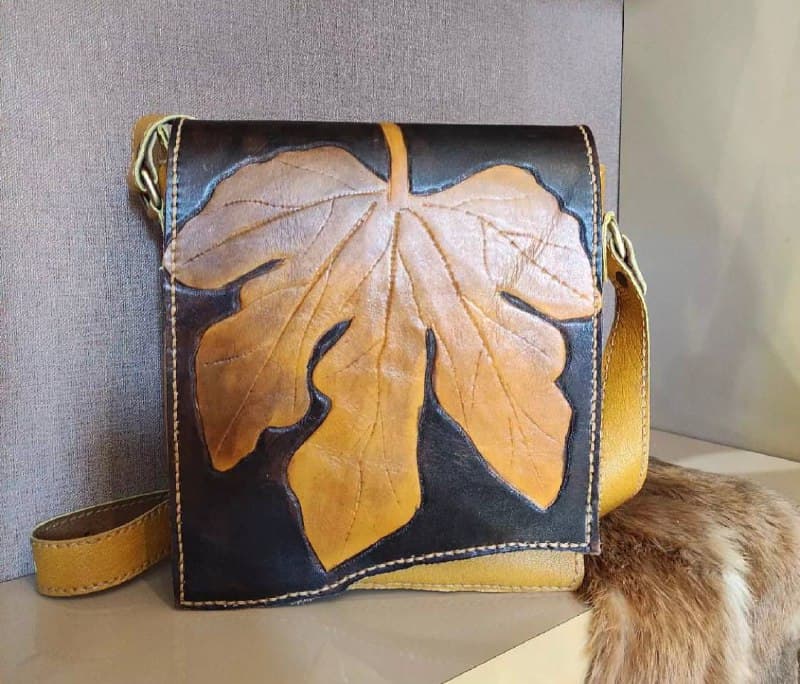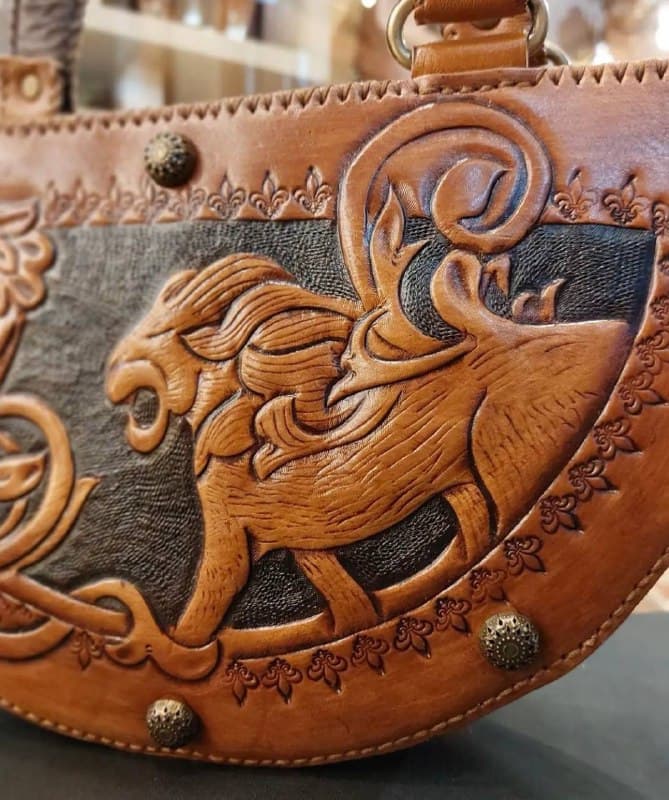Leather bag sewing tutorial
Creating a leather bag involves several steps, including cutting, sewing, and assembling. Below is a simplified tutorial on how to sew a basic leather bag. Keep in mind that working with leather requires specialized tools and skills, so take precautions and practice on scrap leather before attempting a full project. How to sew leather shoes and Types of Iranian bags Iranian handicrafts, buying and selling from Iran handicrafts

Materials You’ll Need: How to sew leather shoes and Types of Iranian bags Iranian handicrafts, buying and selling from Iran Leather bag sewing tutorial
- Leather pieces (pre-cut or cut to your desired size and shape) shop carpet
- Ruler and rotary cutter or leather scissors
- Leather sewing machine or heavy-duty sewing machine with a leather needle
- Heavy-duty nylon or polyester thread
- Clips or leather glue
- Leather hole punch or awl
- Leather edge burnisher or gum tragacanth
- Edge beveler (optional)
- Leather dye and applicator (optional)
- Leather conditioner and finish (optional)

Steps: How to sew leather shoes and Types of Iranian bags Iranian handicrafts, buying and selling from Iran Leather bag sewing tutorial
- Cutting the Leather:
- Begin by cutting the leather pieces for your bag. You’ll typically need a front piece, a back piece, and two side panels. Make sure your pieces are the correct size and shape for your bag design.
- Prepare the Sewing Machine:
- Use a leather needle in your sewing machine, and adjust the thread tension and stitch length for leather. It’s essential to use a heavy-duty machine capable of handling thick leather.
- Mark Stitching Lines:
- Use a ruler or edge guide to mark stitching lines on the leather pieces. You can mark them on the wrong side of the leather using a water-soluble pen or chalk. handmade carpet
- Glue or Clip the Pieces:
- Apply a small amount of leather glue along the stitching lines or use clips to hold the leather pieces together. Ensure the edges are aligned correctly.
- Punch Stitching Holes:
- Use a leather hole punch or awl to create evenly spaced stitching holes along the marked lines. Make sure the holes are large enough to accommodate your thread.
- Begin Stitching:
- Thread your sewing machine with heavy-duty thread. Starting at one end, sew along the stitching line, using a backstitch at the beginning and end to secure the thread. Maintain a consistent seam allowance.
- Backstitch at Corners:
- When you reach a corner, pivot the leather, lift the presser foot, and turn the leather before continuing to sew. Backstitch at the corner to reinforce it.
- Continue Stitching:
- Continue sewing around the bag, keeping your stitches even and aligned with the stitching holes.
- Secure the End:
- Backstitch again at the end to secure the thread. Trim any excess thread.
- Burnish Edges:
- If desired, use a leather edge burnisher or gum tragacanth to smooth and round the edges of your bag for a polished look.
- Dye and Finish (Optional):
- If you want to add color to your bag, you can dye it using leather dye and an applicator. Follow the manufacturer’s instructions for the dye. Once the dye is dry, you can apply a leather conditioner and finish for protection and shine.
- Assemble the Bag:
- Fold and align the leather pieces to create the shape of your bag. Use clips or glue to hold them in place. Depending on your design, you may need to sew additional seams or add straps, handles, and closures.
- Final Stitching (if needed):
- Stitch any remaining seams or attachments, such as straps or handles, to complete your bag. machine carpets.
- Finish and Care:
- Give your leather bag a final inspection, ensuring all stitching is secure. Apply any finishing touches or hardware. Properly care for your leather bag by cleaning and conditioning it as needed to maintain its appearance and longevity.

Remember that working with leather can be challenging, and precision is crucial for a professional result. If you\’re new to leatherworking, consider taking a class or seeking guidance from experienced leathercrafters to improve your skills. How to sew leather shoes and Types of Iranian bags Iranian handicrafts, buying and selling from Iran(silk carpet )
How to sew leather shoes and Types of Iranian bags Leather bag sewing tutorial
Sewing leather shoes is a specialized craft that requires skill and the right equipment. Here’s a simplified overview of how to sew leather shoes, as well as some common types of Iranian bags: vitreous enamel

How to Sew Leather Shoes:
Creating leather shoes from scratch is a complex process that involves multiple steps and requires specialized tools and materials. Below are the fundamental steps involved in making leather shoes: backgammon
Materials You’ll Need:
- Leather pieces for the upper and sole
- Shoe lasts (molds)
- Leatherworking tools: leather scissors, awl, leather needles, waxed thread
- Cement or adhesive
- Hammer and nails (for attaching the sole)
- Shoe laces or other closures

Steps: How to sew leather shoes and Types of Iranian bags Iranian handicrafts, buying and selling from Iran Leather bag sewing tutorial
- Design and Pattern: Start by designing the style and pattern of your shoes. Create a pattern for the upper part of the shoe (vamp, quarters, etc.), and cut the leather pieces according to your pattern.
- Stitching the Uppers: Use a strong waxed thread and a leather needle to sew the various leather pieces together, forming the upper part of the shoe. You’ll typically use a saddle stitch for leatherwork, which is a strong and durable stitch.
- Lasting: Stretch the upper over a shoe last (mold) to give it its final shape. Cement or glue may be used to secure the upper to the last.
- Sole Attachment: Attach the sole to the shoe by sewing it to the upper or using adhesive. Alternatively, you can use nails and a hammer to secure the sole in place. inlaid work
- Finishing: Trim any excess leather, burnish the edges, and add any final touches such as eyelets for laces or decorative elements.
- Laces or Closures: Depending on your shoe design, add laces, buckles, or other closures.
- Quality Control: Inspect the shoe for any imperfections or loose stitches. Make any necessary adjustments or repairs.
- Conditioning: Apply leather conditioner to keep the leather soft, supple, and protected.

Creating leather shoes is a highly specialized craft, and this simplified guide only scratches the surface. It’s recommended that you learn from experienced shoemakers or take formal courses if you wish to pursue shoemaking as a serious hobby or profession. filigree
Types of Iranian Bags: How to sew leather shoes and Types of Iranian bags Iranian handicrafts, buying and selling from Iran Leather bag sewing tutorial
Iran has a rich tradition of bag making, and various regions of the country produce unique types of bags, often reflecting local culture and craftsmanship. Here are some common types of Iranian bags: Turquoise Inlaying

- Kilim Bags: Kilim is a traditional Persian flat-woven textile with colorful patterns. Kilim bags are often made using this textile for the body of the bag, combined with leather or fabric for the straps and trim.
- Qalamkar Bags: Qalamkar is another traditional Persian textile with hand-painted or block-printed designs. Qalamkar bags feature these unique designs and are often used for carrying personal items.
- Carpet Bags: Iran is famous for its handwoven carpets, and some artisans repurpose old or damaged carpets into bags. These bags can feature intricate carpet designs and are both functional and decorative.
- Nomadic Bags: Various nomadic tribes in Iran craft their own distinctive bags, often using techniques such as felting, embroidery, and weaving. These bags are often used for carrying belongings while on the move.
- Leather Bags: Iran produces a wide range of leather bags, from traditional saddlebags to contemporary styles. Leather bags can be found in various shapes, sizes, and designs, and they are highly prized for their quality and craftsmanship.
- Qajar Purses: These small purses are inspired by the Qajar period of Persian history (18th to 19th centuries). They are often intricately decorated with beadwork, embroidery, and metal elements. Leather bag sewing tutorial Handicrafts

When purchasing Iranian bags, consider the region of origin and the materials used, as each type has its own unique characteristics and cultural significance. Iranian bags often showcase the country’s rich heritage and craftsmanship. How to sew leather shoes and Types of Iranian bags Iranian handicrafts, buying and selling from Iran
